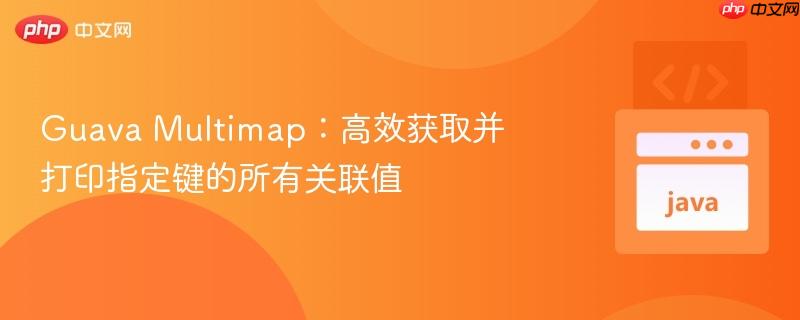
guava multimap是处理一键多值映射关系的强大工具。要获取特定键的所有关联值,应直接使用其提供的`multimap#get(k)`方法。该方法会返回一个包含所有匹配值的`collection`,即使键不存在,也会返回一个空集合而非`null`,从而简化了值检索和空值处理逻辑,是比手动迭代键集更简洁高效的解决方案。
在Java标准库中,java.util.Map 接口定义了键到值的映射关系,其中每个键最多只能关联一个值。然而,在许多实际应用场景中,我们需要一个键能够关联多个值。例如,一个字典中的单词可以有多个同义词,或者一个用户可以拥有多个角色。为了解决这一“一键多值”的需求,Google Guava 库提供了 Multimap 接口及其多种实现。
从概念上讲,Multimap 可以有两种理解方式:
a -> 1 a -> 2 a -> 4 b -> 3 c -> 5
a -> [1, 2, 4] b -> [3] c -> [5]
这两种视角都指向了 Multimap 的核心功能:允许一个键对应多个值。
在不熟悉 Multimap 特性时,开发者可能会尝试通过迭代键集来查找并获取关联值。例如,以下代码片段展示了一种常见的尝试:
// 假设 dictionaryGG 是一个 Multimap 实例
// userInput 是用户输入的键
dictionaryGG.keys().forEach((key) -> {
if (userInput.equals(key)) {
System.out.println("用户输入等于键");
// 尝试访问 'value',但 'value' 在此作用域内未定义,会导致编译错误
// System.out.println("与匹配键关联的值:" + value);
}
});这段代码的问题在于,dictionaryGG.keys() 返回的是所有键的集合(可能包含重复键),迭代它只能获取到键本身。在 forEach 循环内部,并没有直接的方法来访问与当前 key 关联的 value。即使能够获取到键,这种方法也效率低下,因为它需要手动匹配键,并且无法直接获取到所有关联的值集合。正确的做法是利用 Multimap 自身提供的API来高效地检索值。
Guava Multimap 接口提供了一个简洁而强大的方法 get(K key),用于获取与指定键关联的所有值。这个方法返回一个 Collection
方法签名:Collection
核心特点:
下面是一个使用 Multimap#get(K) 方法获取并打印关联值的示例:
import com.google.common.collect.ArrayListMultimap;
import com.google.common.collect.Multimap;
import java.util.Collection;
public class MultimapValueRetrieval {
public static void main(String[] args) {
// 1. 创建并填充一个Guava Multimap 实例
// ArrayListMultimap 允许键和值重复,并保持插入顺序
Multimap<String, String> dictionaryGG = ArrayListMultimap.create();
// 为键 "apple" 关联多个值
dictionaryGG.put("apple", "red");
dictionaryGG.put("apple", "fruit");
dictionaryGG.put("apple", "sweet");
// 为键 "banana" 关联值
dictionaryGG.put("banana", "yellow");
dictionaryGG.put("banana", "fruit");
// 为键 "grape" 关联值
dictionaryGG.put("grape", "purple");
// 2. 模拟用户输入,获取指定键的关联值
String userInputKey1 = "apple";
Collection<String> values1 = dictionaryGG.get(userInputKey1);
System.out.println("用户输入的键: '" + userInputKey1 + "'");
System.out.println("关联的值: " + values1); // 输出: 关联的值: [red, fruit, sweet]
System.out.println("--------------------");
String userInputKey2 = "banana";
Collection<String> values2 = dictionaryGG.get(userInputKey2);
System.out.println("用户输入的键: '" + userInputKey2 + "'");
System.out.println("关联的值: " + values2); // 输出: 关联的值: [yellow, fruit]
System.out.println("--------------------");
// 3. 处理键不存在的情况
String nonExistentKey = "orange";
Collection<String> emptyValues = dictionaryGG.get(nonExistentKey);
System.out.println("用户输入的键: '" + nonExistentKey + "'");
System.out.println("关联的值: " + emptyValues); // 输出: 关联的值: [] (返回一个空的Collection)
// 可以进一步迭代或处理获取到的集合
if (!emptyValues.isEmpty()) {
System.out.println("橙子存在关联值。");
} else {
System.out.println("橙子没有关联值。");
}
}
}Guava Multimap 是处理“一键多值”场景的强大工具,而 Multimap#get(K) 方法则是获取与指定键关联的所有值的标准、高效且推荐的方式。通过理解 Multimap 的概念及其 get(K) 方法的特性,开发者可以编写出更清晰、更健壮、更符合惯用法的代码来管理复杂的数据映射关系。避免手动迭代键集并尝试查找关联值的低效做法,直接利用 Multimap 提供的API是最佳实践。
以上就是Guava Multimap:高效获取并打印指定键的所有关联值的详细内容,更多请关注php中文网其它相关文章!

Copyright 2014-2025 https://www.php.cn/ All Rights Reserved | php.cn | 湘ICP备2023035733号